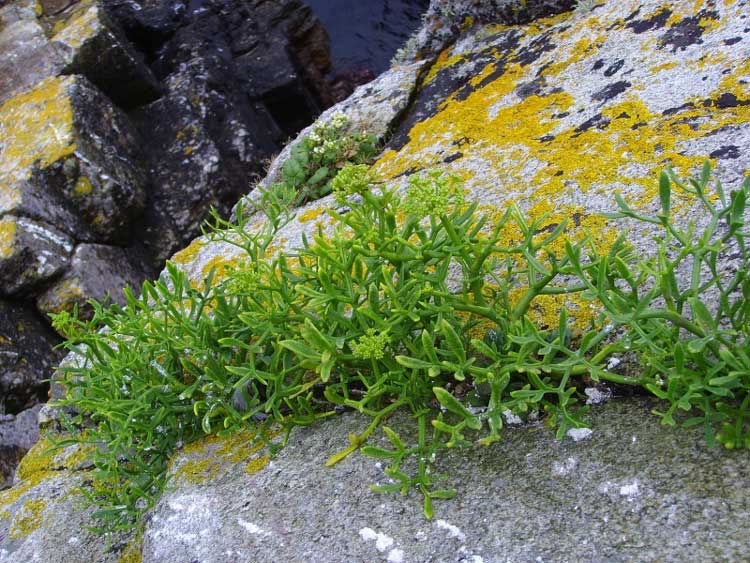
Crithmum maritimum
Classification System: APG IV
Superregnum: Eukaryota
Regnum: Plantae
Cladus: Angiosperms
Cladus: Eudicots
Cladus: Core eudicots
Cladus: Asterids
Cladus: Campanulids
Ordo: Apiales
Familia: Apiaceae
Subfamilia: Apioideae
Tribus: Pyramidoptereae
Genus: Crithmum
Species: Crithmum maritimum
Name
Crithmum maritimum L., Sp. Pl. 1: 246. 1753.
Synonyms
Homotypic
Cachrys maritima (L.) Spreng., Pl. Umb. Prodr., 20. 1813.
Heterotypic
Crithmum canariense Cav., Anal. Cienc. Nat., 3: 35. 1801.
Distribution
Native distribution areas:
Continental: Europe
Regional: Northern Europe
Great Britain, Ireland (Ireland, Northern Ireland), Norway (introduced)
Regional: Middle Europe
Germany (Helgoland, introduced), Netherlands
Regional: Southwestern Europe
Baleares (Ibiza with Formentera, Mallorca, Menorca), Corse, France (France, Monaco), Portugal, Sardegna, Spain (Gibraltar, Spain)
Regional: Southeastern Europe
Albania, Bulgaria, Greece, Italy, Kriti, Romania, Sicilia (Sicily, Malta), Turkey-in-Europe, Yugoslavia (Croatia, Montenegro, Slovenia)
Regional: Eastern Europe
Krym
Continental: Africa
Regional: Northern Africa
Algeria, Egypt (NW-coastal Egypt), Libya, Morocco, Tunisia
Regional: Macaronesia
Azores (Corvo, Faial, Flores, Graciosa, Pico, Santa Maria, Sao Jorge, Sao Miguel, Terceira), Canary Islands (Gran Canaria, Gomera, Hierro, La Palma, Tenerife, Fuerteventura)
Continental: Asia-Temperate
Regional: Caucasus
North Caucasus, Transcaucasus (Gruziya)
Regional: Western Asia
Cyprus (E-Cyprus N-Cyprus, S-Cyprus, W-Cyprus), East Aegean Islands, Lebanon-Syria (Lebanon: coastal W-Lebanon, Syria: coastal W-Syria), Palestine (Israel: coastal W-Israel), Sinai (N-Sinai), Turkey (N-Anatolia, NE-Anatolia, NW-Anatolia: Bithynia, SSW-Anatolia, W-Anatolia, WN-Anatolia)
References: Brummitt, R.K. 2001. TDWG – World Geographical Scheme for Recording Plant Distributions, 2nd Edition
References
Linnaeus, C. 1753. Species Plantarum. Tomus I: 246. Reference page.
Links
Hassler, M. 2018. Crithmum maritimum. World Plants: Synonymic Checklists of the Vascular Plants of the World In: Roskovh, Y., Abucay, L., Orrell, T., Nicolson, D., Bailly, N., Kirk, P., Bourgoin, T., DeWalt, R.E., Decock, W., De Wever, A., Nieukerken, E. van, Zarucchi, J. & Penev, L., eds. 2018. Species 2000 & ITIS Catalogue of Life. Published on the internet. Accessed: 2018 Aug. 26. Reference page.
International Plant Names Index. 2018. Crithmum maritimum. Published online. Accessed: Aug. 26 2018.
Govaerts, R. et al. 2018. Crithmum maritimum in Kew Science Plants of the World online. The Board of Trustees of the Royal Botanic Gardens, Kew. Published on the internet. Accessed: 2018 Aug. 26. Reference page.
Tropicos.org 2018. Crithmum maritimum. Missouri Botanical Garden. Published on the internet. Accessed: 2018 Aug. 26.
Euro+Med 2006 onwards: Crithmum maritimum in Euro+Med PlantBase – the information resource for Euro-Mediterranean plant diversity. Published on the internet. Accessed: 2018 Nov 27.
USDA, ARS, Germplasm Resources Information Network. Crithmum maritimum in the Germplasm Resources Information Network (GRIN), U.S. Department of Agriculture Agricultural Research Service. Accessed: 08-Apr-12.
FloraWeb
Vernacular names
Deutsch: Meerfenchel
English: Sea fennel
suomi: Merifenkoli
français: Fenouil marin
italiano: Finocchio marino
sardu: Fenùju de mare
Türkçe: Deniz rezenesi
vèneto: Senòcio, Sanòcio
Crithmum is a monospecific genus of flowering plant in the carrot family Apiaceae, with the sole species Crithmum maritimum, known as rock samphire,[1][2] sea fennel[1] or samphire.[1] The name "samphire" is also used for several other unrelated succulent halophyte species of coastal plant.
Sea fennel, or Rock samphire, is an edible wild plant. It is found on southern and western coasts of Britain and Ireland, on Mediterranean and western coasts of Europe and in the Canary Islands, North Africa and on the coast of the Black Sea.
History, trade and cultivation
In the 17th century, Shakespeare in King Lear referred to the dangerous practice of collecting rock samphire from cliffs. "Half-way down, Hangs one that gathers samphire; dreadful trade!"[3] In the 19th century, samphire was being shipped in casks of seawater from the Isle of Wight to market in London at the end of May each year.[4] Rock samphire used to be cried in London streets as "Crest Marine".[5]
In England, rock samphire was cultivated in gardens,[5] where it grows readily in a light, rich soil. Obtaining seed commercially is now difficult, and in the United Kingdom the uprooting of wild plants is illegal under the Wildlife and Countryside Act 1981.
The reclaimed piece of land adjoining Dover, called Samphire Hoe, is named after rock samphire. The land was created from spoil from the Channel Tunnel, and rock samphire used to be harvested from the neighbouring cliffs.
Culinary use
This section needs additional citations for verification. Please help improve this article by adding citations to reliable sources. Unsourced material may be challenged and removed. (June 2021) (Learn how and when to remove this template message)
Rock samphire or sea fennel has fleshy, divided aromatic leaves that Culpeper described as having a "pleasant, hot and spicy taste"[6]
The stems, leaves and seed pods may be pickled in hot, salted, spiced vinegar, or the leaves used fresh in salads.
Sea fennel pickle in olive oil or vinegar is a traditional food of Italy (Marche region), Croatia (Dalmatia), Greece, and Montenegro (Bay of Kotor). It is known as Paccasassi del Conero and used as an antipasto, to accompany fish and meat dishes and to garnish pizza and sandwiches.
Richard Mabey gives several recipes for rock samphire,[7] although it is possible that at least one of these may refer to marsh samphire or glasswort (Salicornia europaea), a very common confusion.
Properties
Sea fennel has nutritional value, being rich in vitamin C, vitamins E and K, iodine, carotenoids and flavonoids. It is also rich in antioxidants and in omega-3 fatty acids. The consumption of sea fennel was common among seafarers as a valuable aid for the prevention of scurvy.
References
"Crithmum maritimum". Germplasm Resources Information Network (GRIN). Agricultural Research Service (ARS), United States Department of Agriculture (USDA). Retrieved 13 March 2014.
BSBI List 2007 (xls). Botanical Society of Britain and Ireland. Archived from the original (xls) on 26 June 2015. Retrieved 17 October 2014.
Shakespeare, William (1623). The Tragedy of King Lear. London. Act IV, scene VI, lines 14b-15
Grigson, Geoffrey (1958). The Englishman's Flora. London: The Readers' Union, Phoenix House.
Phillips, Roger (1983). Wild Food. Pan. ISBN 0-330-28069-4.
Culpeper, Nicholas (1653). The Complete Herbal. London.
Mabey, Richard (1975). Food For Free. Fontana. ISBN 0-00-613470-X.
Retrieved from "http://en.wikipedia.org/"
All text is available under the terms of the GNU Free Documentation License

